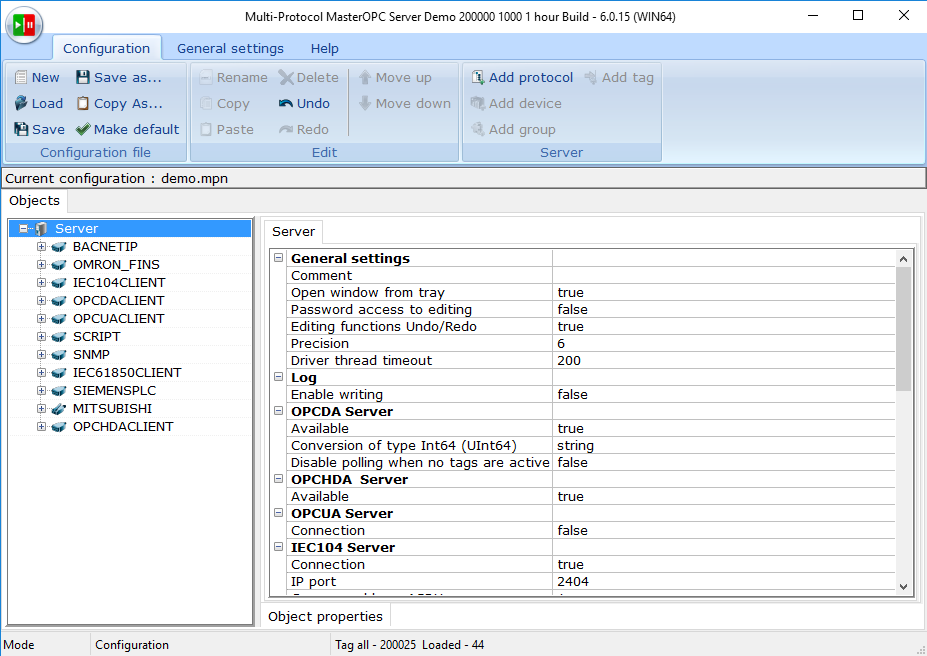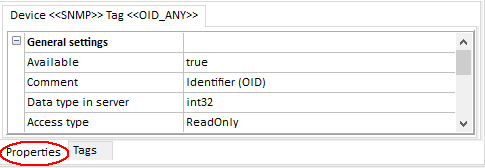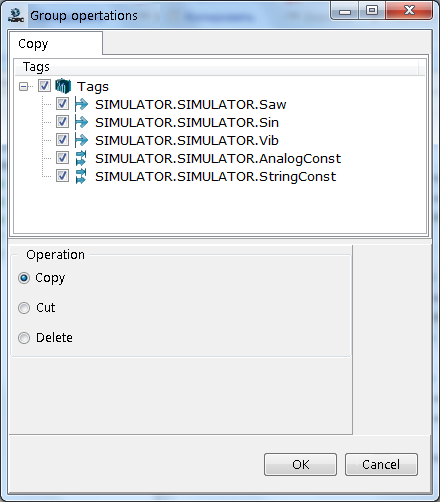Design-Time Interface
![]() The 'Group Operations' Command
The 'Group Operations' Command
The screenshot below demonstrates what the server window looks like in the design-time mode:

In that mode, the shell contains the following main areas:
![]() The menu area – contains the tabs Configuration, General Settings and Help.
The menu area – contains the tabs Configuration, General Settings and Help.
While loading/saving a configuration, the area, for a short time, displays maximal number of tags according to the license (Licensed) as well as number of tags loaded and initialized (respectively Loaded and Initialized):

![]() The Objects area – the object tree
The Objects area – the object tree
![]() The area of parameters – contains two tabs:
The area of parameters – contains two tabs:
![]() Properties – editor of an object highlighted in the tree:
Properties – editor of an object highlighted in the tree:

![]() Tags – a table of tags of an object highlighted in the tree:
Tags – a table of tags of an object highlighted in the tree:

The table contains tag parameters configured in the respective dialog (see The Dialog of Server Parameters ).
You can twice click a tag string in the table in order to highlight the tag in the tree and open that tag in the editor.
Standard multiple selection with holding CTRL or SHIFT is supported in the table.
The context table menu contains the following commands:

– Select all – select all of tags (being used, the command is replaced by the Deselect command)
– Group operations – see The 'Group Operations' Command .
Under the menu area, a name of the current configuration file is displayed (see Server Configuration ):
![]()
The status bar (in the bottom window part) displays a server mode (following the words Server mode) as well as license limitations:
![]() If the root group Server is selected – maximal number of tags for the product (Tags all) and number of tags loaded in all of nodes (Loaded):
If the root group Server is selected – maximal number of tags for the product (Tags all) and number of tags loaded in all of nodes (Loaded):
![]()
![]() If a node or any node object is selected – a license type (License for tags or License for devices).
If a node or any node object is selected – a license type (License for tags or License for devices).
In the first case, the status bar displays a maximal number of tags according to the license (Licensed), a number of node tags loaded (Loaded), a maximal number of tags for the product (Tags all), and a total number of tags loaded in all of nodes (Loaded).
![]()
In the second case, the status bar displays a maximal number of devices according to the license (Licensed), a number of node devices loaded (Loaded), a maximal number of tags for the product (Tags all), and a total number of tags loaded in all of nodes (Loaded).
In the editors and dialogs, the context help is available (by F1).
The ’Group Operations’ Command
This command is available in the context menu of the Tags table. Upon this command, the next dialog is opened (the dialog contains tags, which have been highlighted in the Tags table before execution of the command Group Operations):

The dialog is provided for group copying, cutting or deleting tags. To do this, use the Copy, Cut or Delete tab respectively. If an operation must be executed on a tag, a flag of that tag at the respective tab must be set ON ( ![]() ). If the flag is OFF (
). If the flag is OFF ( ![]() ), an operation will not be executed on the tag. To set the flag ON/OFF to click it. If a flag of a group is set ON/OFF, then flags of all of tags of that group are set ON/OFF (including tags in sub-groups). To execute an operation to click the OK button. To cancel an operation to click the Cancel button.
), an operation will not be executed on the tag. To set the flag ON/OFF to click it. If a flag of a group is set ON/OFF, then flags of all of tags of that group are set ON/OFF (including tags in sub-groups). To execute an operation to click the OK button. To cancel an operation to click the Cancel button.